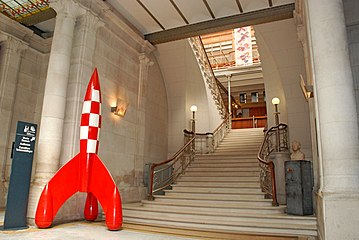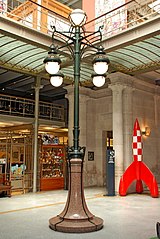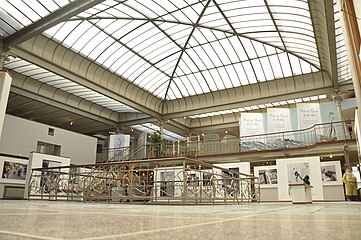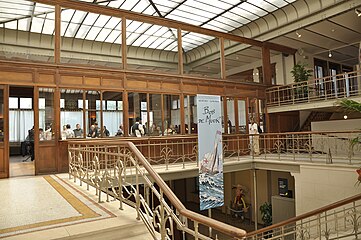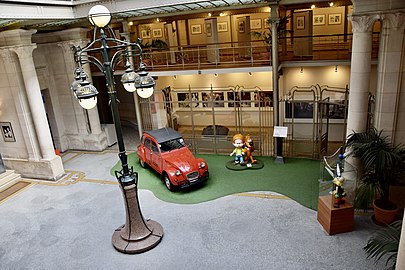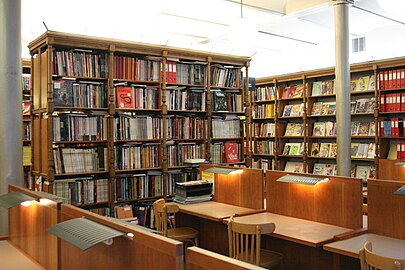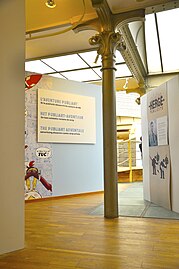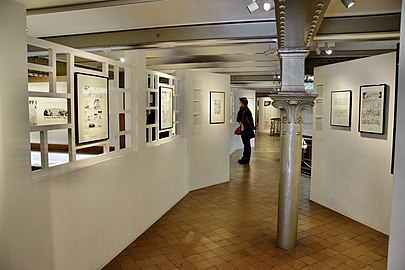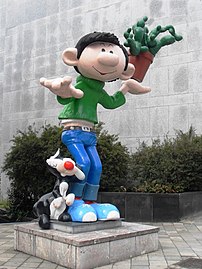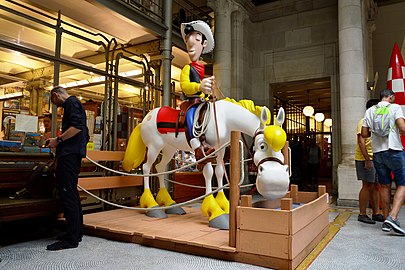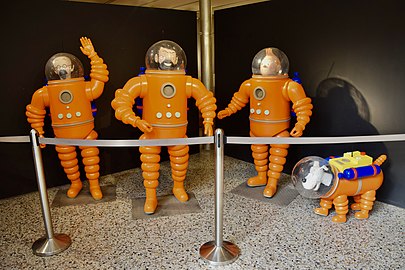Belgian Comic Strip Center
 Exterior of the museum | |
 Interactive fullscreen map | |
| Established | 6 October 1989[1] |
|---|---|
| Location | Rue des Sables / Zandstraat 20, 1000 City of Brussels, Brussels-Capital Region, Belgium |
| Coordinates | 50°51′04″N 4°21′36″E / 50.85111°N 4.36000°E |
| Type | History of Belgian comics |
| Visitors | More than 200,000 per year[1] |
| Public transit access | |
| Website | Official website |
The Belgian Comic Strip Center (French: Centre belge de la Bande dessinée; Dutch: Belgisch Stripcentrum) is a museum in central Brussels, Belgium, dedicated to Belgian comics. It is located at 20, rue des Sables/Zandstraat, in an Art Nouveau building designed by Victor Horta, and can be accessed from Brussels-Congress railway station and Brussels-Central railway station.
History of the building
[edit]The building was designed in 1905 by the world-famous architect Victor Horta, in Art Nouveau style, and served as a textile department store, the Magasins Waucquez. After Waucquez's death in 1920, the building began to languish away, and in 1970, the firm closed its doors. Jean Delhaye, a former aide of Horta, saved the building from demolition, and by 16 October 1975, it was designated as a protected monument. Still, the building was in bad shape and victim to a lot of vandalism.[2]
In 1980, the architect Jean Breydel and the comics artists François Schuiten, Bob de Moor, Alain Baran, Guy Dessicy, and Hergé, planned to restore the building and give it a new destination as a museum dedicated to the history of Belgian comics. Originally, the museum would be a homage to Hergé, but he suggested honouring the entire Belgian comics industry. In 1983, Belgian Minister of Public Works, Louis Olivier, decided that the building would be bought by the Direction of Buildings, making it national property.[2] In 1984, a fund was founded, which brought together several Flemish and Walloon comics artists. Two years later, the restorations began, with respect for the original architecture, while updating it to modern standards. The mosaics were flown over from Italy and constructed by Italian mosaic workers, because the profession had become obsolete in Belgium.[2]
On 6 October 1989, the museum was inaugurated in the presence of King Baudouin and Queen Fabiola.[3]
In the Autumn of 2015, the museum started redecorating its permanent exhibition.[4]
-
Entrance staircase
-
Art Nouveau lamppost
-
Main skylight on the second floor
-
Second floor
The museum
[edit]The ground floor of the museum holds a restaurant, a room dedicated to Victor Horta, a comics' store named "Slumberland" after Little Nemo in Slumberland,[5] a library with a reading room and a study centre. The first floor has an auditorium, a room with original comic book pages by various artists and a room dedicated to animation, more specifically the Belgian animation industry, such as Belvision.[2]
The second floor has a permanent exhibition dedicated to the chronological history of the medium in Belgium called "The Museum of Imagination".[5] The exhibit starts off with Hergé and ends with Peyo, covering the pioneers of Belgian comics between 1929 and 1958 and with special focus on the magazines Spirou and Tintin. Each artist has a room dedicated to his work and designed in a playful way.[2][6]
The final floor is dedicated to the merchandising of comics and available for provisional exhibitions.[2]
-
Entrance hall
-
Library
-
Entrance to the PUBLIART space
-
Exhibition space
List of the exhibited comics artists
[edit]Four artists exhibited are Flemish: Willy Vandersteen, Marc Sleen, Bob de Moor and Morris. The rest are Walloon or from Brussels, except for Jacques Martin and Tibet who were born in France, but published in Tintin.
- Hergé - (The Adventures of Tintin, Quick and Flupke, Jo, Zette and Jocko)
- Jijé - (Spirou et Fantasio, Jerry Spring)
- Edgar P. Jacobs - (Blake and Mortimer)
- Willy Vandersteen - (Suske en Wiske)
- Marc Sleen - (The Adventures of Nero)
- Maurice Tillieux - (Gil Jourdan)
- Bob De Moor - (Cori, de Scheepsjongen)
- André Franquin - (Spirou et Fantasio, Marsupilami, Gaston Lagaffe, Franquin's Last Laugh)
- Jacques Martin - (The Adventures of Alix)
- Morris - (Lucky Luke)
- Paul Cuvelier - (Corentin)
- Victor Hubinon - (Buck Danny)
- Tibet - (Chick Bill, Ric Hochet)
- Raymond Macherot - (Chlorophylle, Sybilline)
- Jean Roba - (Boule et Bill)
- Peyo - (Johan and Peewit, The Smurfs)
Marc Sleen Museum
[edit]Since 2009, directly across the Belgian comics museum, in the same street, another comics-themed museum can be found, the Marc Sleen Museum, dedicated to the work of Belgian comics artist Marc Sleen. On 30 January 2023, it was announced that the museum would close down in the autumn, with part of the collection being integrated into the Belgian Comic Strip Center.[7][8][9]
See also
[edit]- List of museums in Brussels
- Brussels' Comic Book Route
- Art Nouveau in Brussels
- History of Brussels
- Culture of Belgium
- Belgium in the long nineteenth century
References
[edit]Citations
[edit]- ^ a b "About Us—In Short". Brussels, Belgium: Belgian Comic Strip Center. Retrieved 4 July 2011.
- ^ a b c d e f "Belgisch Centrum van het Beeldverhaal Brussel" [Belgian Comic Strip Center Brussels] (PDF). Openbaar Kunstbezit Vlaanderen (in Dutch). Archived from the original (PDF) on 22 December 2015. Retrieved 7 November 2015.
- ^ "Belgian Comic Strip Center". City of Brussels. Archived from the original on 24 September 2014. Retrieved 21 September 2014.
- ^ "De Hergéruimte" [The Hergé Room]. Stripmuseum Brussel (in Dutch). Archived from the original on 11 April 2021. Retrieved 7 November 2015.
- ^ a b "Belgian Comic Strip Center". Brussels' Museums. Archived from the original on 19 September 2015. Retrieved 7 November 2015.
- ^ "Drawing room: The Belgian Comic Strip Center: Tintin". The Independent. 15 October 2011. Retrieved 22 December 2012.
- ^ "Einde verhaal voor Marc Sleen Museum".
- ^ "Marc Sleen Museum wordt onderdeel van het Belgisch Stripcentrum". Het Laatste Nieuws (in Dutch). 31 January 2023. Retrieved 17 November 2023.
- ^ "Marc Sleen Museum stopt en wordt onderdeel van Stripmuseum Brussel". 31 January 2023.
Bibliography
[edit]- Geert De Weyer, België gestript (in Dutch), Lannoo, Tielt (2005), p. 77–78 (ISBN 978-9-462-10202-6)
- Le Patrimoine monumental de la Belgique: Bruxelles (PDF) (in French). Vol. 1C: Pentagone N-Z. Liège: Pierre Mardaga. 1994. pp. 268–270.
External links
[edit] Media related to Belgian Centre for Comic Strip Art at Wikimedia Commons
Media related to Belgian Centre for Comic Strip Art at Wikimedia Commons- Official website
- Museums in Brussels
- City of Brussels
- Art museums and galleries in Belgium
- Belgian comics
- Cartooning museums
- The Adventures of Tintin
- Art museums and galleries established in 1989
- 1989 establishments in Belgium
- Art Nouveau architecture in Brussels
- Art Nouveau retail buildings
- Art Nouveau museum buildings
- Victor Horta buildings
- Comics-related organizations

